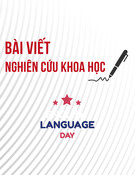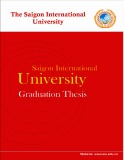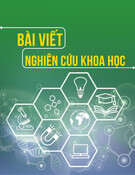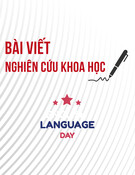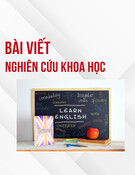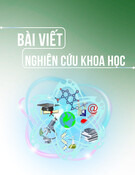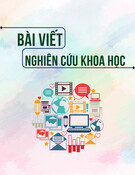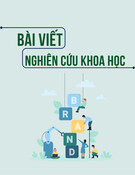
TNU Journal of Science and Technology
230(03): 22 - 29
http://jst.tnu.edu.vn 22 Email: jst@tnu.edu.vn
ENGLISH-MAJORS’ PERCEPTIONS OF TEACHER CREATIVITY
IN TEACHING ENGLISH SPEAKING SKILLS
Pham Thi Kim Anh*
Ho Chi Minh City University of Technology and Education
ARTICLE INFO
ABSTRACT
Received:
07/10/2024
This quantitative research aims to examine 75 EFL students’
perspectives of teacher creativity in teaching English speaking skills at
the Faculty of Foreign Languages, Ho Chi Minh City University of
Technology and Education. Using Kharkhurin’s (2014) conceptual
framework of creativity, the paper focuses on four dimensions of
teachers’ novelty, utility, aesthetics and authentic attributes in teaching
English speaking skills. The data were collected through a five-point
Likert scale questionnaire and analyzed by SPSS software concerning
the values of mean, standard deviation, and percentage. The findings
reveal that students highly valued teachers’ novelty in material
development, instructional activities, testing, classroom management,
plus the aesthetic and authentic values and the benefits that teachers’
creativity brought in the EFL speaking classroom. Nevertheless, the
teachers’ usage of digital information technology for classroom
interaction needed to be improved. The study draws a picture of EFL
teachers’ creativity in English speaking teaching from learners’
perspectives to gain deeper insights into English speaking teaching
practices, and calls for more effective application of technology-based
learning for the sake of more efficient classroom interaction in the EFL
context.
Revised:
10/02/2025
Published:
11/02/2025
KEYWORDS
Teacher creativity
Teaching English speaking
EFL students
Perceptions
Kharkhurin (2014)
NHẬN THỨC CỦA SINH VIÊN CHUYÊN NGỮ VỀ SỰ SÁNG TẠO
CỦA GIÁO VIÊN TRONG GIẢNG DẠY KỸ NĂNG NÓI TIẾNG ANH
Phạm Thị Kim Ánh
Trường Đại học Sư phạm Kỹ thuật Thành phố Hồ Chí Minh
THÔNG TIN BÀI BÁO
TÓM TẮT
Ngày nhận bài:
07/10/2024
Nghiên cứu định lượng này nhằm tìm hiểu nhận thức của 75 sinh viên
tại Khoa Ngoại ngữ, trường Đại học Sư phạm Kỹ thuật Thành phố Hồ
Chí Minh về sự sáng tạo của giáo viên trong giảng dạy kỹ năng nói
tiếng Anh. Khung khái niệm của Kharkhurin (2014) về sự sáng tạo
gồm sự đổi mới, lợi ích, giá trị thẩm mĩ và thực tiễn được sử dụng
trong bài viết này. Dữ liệu được thu thập bằng bảng câu hỏi theo thang
đo Likert năm mức độ và được phân tích bởi phần mềm SPSS về các
giá trị trung bình, độ lệch chuẩn và tỷ lệ phần trăm. Kết quả đạt được
thể hiện rằng người học đánh giá cao sự đổi mới của giáo viên trong
phát triển tài liệu, hoạt động giảng dạy, quản lý lớp, kiểm tra - đánh
giá, cùng các giá trị thẩm mĩ và thực tiễn từ sự sáng tạo của giáo viên.
Tuy nhiên, việc áp dụng công nghệ thông tin cho sự tương tác trong
lớp học cần được cải thiện. Bài viết cung cấp thông tin về sự sáng tạo
của giáo viên từ quan điểm của người học nhằm hiểu rõ hơn thực tiễn
giảng dạy kỹ năng nói tiếng Anh bậc đại học, và nêu lên nhu cầu của
dạy và học dựa trên công nghệ thông tin nhằm tăng cường sự tương tác
trong lớp học hiệu quả hơn.
Ngày hoàn thiện:
10/02/2025
Ngày đăng:
11/02/2025
TỪ KHÓA
Sự sáng tạo của giáo viên
Giảng dạy nói tiếng Anh
Sinh viên chuyên ngữ
Nhận thức
Kharkhurin (2014)
DOI: https://doi.org/10.34238/tnu-jst.11260
*Email: anhptk@hcmute.edu.vn









